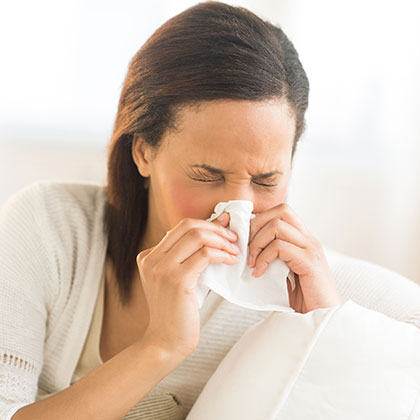Glandular fever – or infectious mononucleosis (mono for short) – is a viral infection that can affect anyone of any age, but is most usually found in young adults and teenagers (i).
The virus that most often causes glandular fever – called the Epstein-Barr virus (see below) – is thought to infect people in childhood, when most Epstein-Barr virus infections are thought to go unnoticed, since the symptoms the virus causes are often mild to non-existent in children (ii).

Once you’ve had the virus, you’ll most likely be immune to any further infections for the rest of your life, as it’s rare for someone to have glandular fever more than once. But if you didn’t have the virus as a child then go on to develop an infection as a teenager or adult, the result can be glandular fever (people over the age of 40 can also be infected with the virus and not develop any symptoms). Around one in every 200 people is estimated to develop glandular fever in any given year (iii).
Mononucleosis symptoms
Symptoms of glandular fever can take around six weeks to develop after you’ve been infected with the virus (iv). These symptoms can make you feel very unwell, and you may have a high temperature, a very painful sore throat that makes it difficult for you to swallow, fatigue and swollen glands in your neck and sometimes other parts of your body (your armpits, for example).
You may also experience chills and sweats, aching muscles, pain around or behind your eyes and you may not feel like eating. Other symptoms also include a cough and/or chest pain, swollen tonsils and adenoids (small lumps of tissue at the back of your nose), your eyes may feel puffy, your stomach may feel swollen and tender (this may be caused by the swelling of your spleen and/or your liver), and you may notice your skin looking more yellow than normal (ie. jaundice).
Generally, your throat will feel at its worst for three to five days after your symptoms start, then it will start to feel better gradually. You may, however, have a high temperature for up to 14 days. While having some or all of these symptoms isn’t exactly pleasant, they shouldn’t last for more than two or three weeks (i). One thing you may be left with for longer, however, is fatigue, and you could feel wiped out for weeks or even months after the other symptoms have gone away.
What is the Epstein-Barr virus?
The Epstein-Barr virus (EBV) is a type of herpes virus – called human herpesvirus 4 – that’s one of the most common viruses that can affect humans. For instance, some experts believe at least 95 percent of the population becomes infected by it (v).
EBV is linked to several diseases, though glandular fever is by far the most common. It was first discovered by three scientists who wrote about human viruses that cause cancer in The Lancet medical journal in March 1964, namely Anthony Epstein, Yvonne Barr and Burt Achong. Indeed, EBV is now known to play a role in several rare cancers, including Burkitt's lymphoma, Hodgkin lymphoma, some nasopharyngeal cancers (cancers of the back of the nose and throat) and some stomach cancers (vi).
The virus has also been linked with other mild childhood illnesses, including ear infections and diarrhoea. In some rare cases, EBV antibodies have been found in people with neurological conditions such as Guillain-Barre syndrome, viral meningitis and encephalitis (infection of the brain).
How is it spread?
EBV is a contagious virus and is mostly passed on through bodily fluids, particularly saliva. This explains why glandular fever is often called the ‘kissing’ disease, since it’s thought to be passed on by kissing or having intimate contact someone who has the virus (it can also be spread during sexual contact through blood and semen).
You can also contract EBV in similar ways as catching a cold – that is, by being exposed to droplets of the virus when an infected person coughs or sneezes around you, or if you share things like toothbrushes, cutlery and crockery with someone who has the virus.
The virus first infects the cells on the lining of your throat, then passes into your bloodstream and your white blood cells. After infecting your white blood cells, it then spreads through your lymphatic system, which explains why your glands – which are part of your lymphatic system – are often affected.
Unfortunately, since the virus can stay in your system for several months after you’ve recovered, you may easily infect other people without realising it. Some people can even have the virus in their saliva on and off for years after having glandular fever.
Similarly, you can spread EBV to others before you have any symptoms, as it can take six weeks or even longer for symptoms to start after you were infected. In some people, the virus – which usually remains inactive in the body after the initial infection – reactivates, usually without causing any symptoms. But if this happens, they may potentially spread the virus to others, again without realising it.
How is glandular fever treated?
There’s currently no cure for glandular fever but there are ways to relieve some of the symptoms, just as you’d relieve the symptoms of a cold or flu. In most cases, the symptoms should pass within a week or two.
Rest up
Many people who get glandular fever experience fatigue, so resting is important (indeed, in most cases, not resting isn’t an option, as you feel so tired). Experts also think you’ll recover faster if you rest as much as possible as soon as your symptoms start. Complete bed rest, on the other hand, isn’t recommended for glandular fever any longer, as it could prolong the fatigue. According to the NHS, start gradually becoming active again when you feel your energy coming back, but be careful not to do too much, and avoid anything that makes you feel tired again (i). You should also avoid activities where there’s a risk of falling for about a month after your symptoms start, such as sports, for instance. This can help prevent any damage to your spleen from a fall or a knock (your spleen may be swollen if you have glandular fever, and any sudden impact could make it rupture) (i).
Drink plenty of fluids
One of the most common symptoms of glandular fever is a severe sore throat, where swallowing can be painful. This may make you reticent to drink much. But it’s important to keep drinking to prevent dehydration, especially if you have a high temperature. If you’re looking after someone with glandular fever, keep an eye on how much they’re drinking, and make sure their fluid intake is adequate (the NHS recommends water or unsweetened fruit juice) (vii). Drinking alcohol when you have glandular fever is not a good idea, however, because of the way glandular fever affects the liver. Try to abstain from any alcohol until your symptoms have gone.
Take pain relief
Taking over-the-counter painkillers such as paracetamol can help soothe a sore throat and aches and pains, as well as reduce a high temperature.
Gargle with salt water
Another way to relieve throat soreness is to gargle with warm salty water, as it can help reduce swelling. Try gargling with about half a teaspoon of salt dissolved in a cup of warm water as regularly as needed.
Meanwhile, there’s no point in taking antibiotics for glandular fever, because antibiotics only kill bacterial infections, not viral infections. But if you develop a secondary bacterial infection such as a bacterial throat infection or pneumonia – which can happen in some glandular fever cases – you may be prescribed antibiotics.
Are there any complications?
If you’re affected by glandular fever, it’s not very likely that you’ll experience any complications. But a small number of people will have other problems after having glandular fever, such as an injured spleen. The spleen sits under the ribs on the left side of the abdomen, and is thought to become swollen in about half of cases of glandular fever. If the spleen is swollen and subsequently becomes damaged, it can rupture – which is very serious and potentially life threatening, as it can cause internal bleeding. This is why people with glandular fever are advised not to engage in any activities where they may fall or otherwise injure their spleen.
Long-lasting fatigue
Around one in every 10 people with glandular fever is thought to experience prolonged fatigue lasting six months or more following the initial infection (iii). Some believe this prolonged fatigue may be a form of chronic fatigue syndrome.
Neurological conditions
Around one in every 100 cases of glandular fever is thought to lead to a condition that affects the nervous system, such as Guillain-Barré syndrome, viral meningitis, encephalitis and Bell’s palsy (iii). Four out of five people affected are expected to make a full recovery with treatment (iii).
Mild depression
Many people also feel low while they’re ill with glandular fever, and for a period afterwards. This, however, usually resolves itself in time. Discover more on depression and how to cope in our guide.
Natural support for glandular fever
As well as taking it easy, drinking lots of fluids and taking over-the-counter painkillers, there are a few things you can do to help yourself if you have glandular fever, including taking natural remedies such as the following:
Siberian ginseng
Described as an adaptogen – a substance that helps the body adapt to different kinds of stress – Siberian ginseng (Elutherococcus senticosus) is thought to be useful as a general support for the immune system. This may be beneficial in cases of glandular fever, since the Epstein-Barr virus that causes it can weaken the immune system, making it harder for the body to fight infection (viii).
Ashwagandha
One of the most important herbs in the Indian natural medicine system Ayurveda, ashwagandha is also classed as an adaptogen. Studies suggest it may also help to strengthen the immune system by increasing the activity of natural killer cells (ix). There’s also some evidence it may help reduce symptoms of depression, with one study finding that people who take ashwagandha extract experience a 79 per cent reduction in symptoms including stress and anxiety compared to just 10 per cent of those taking a placebo (x).
Rhodiola Rosea
Also known as arctic root or golden root, rhodiola is also an adaptogenic herb and is used traditionally throughout Europe for stress relief. It’s also thought to help relieve fatigue, which is common in people with glandular fever. For instance, one four-week study has found taking a rhodiola root extract daily may have a positive effect on fatigue compared with a placebo (xi), while another suggests taking rhodiola extract for eight weeks may help reduce fatigue significantly as well as boost mood and quality of life (xii).
High-strength multivitamin and mineral
If your throat is very sore with glandular fever, you may not feel like eating very much. Taking a good-qualify multivitamin and mineral supplement that includes a range of nutrients may help make sure you get a decent level of nutrition. Getting the right nutrients – including vitamin D, iron and B vitamins – may also help keep your energy levels up as well as support your immune system at a time when you may well feel very run down.
Magnesium
Another way to combat tiredness and fatigue is to take a magnesium supplement. This nutrient is essential for a number of functions in the body, including the production of a molecule called adenosine triphosphate (ATP), which is where your cells store energy from food. Even people who aren’t battling glandular fever may not be getting enough magnesium in their diet (there’s evidence that many adults in the UK don’t get enough magnesium from food (xiii)).
With these helpful steps, managing glandular fever should become a little easier. To discover even more advice on how to cope with a range of health conditions, our health library has a number of helpful articles.
References:
-
Available online: https://www.nhs.uk/conditions/glandular-fever/
-
Available online: https://www.nhsinform.scot/illnesses-and-conditions/infections-and-poisoning/glandular-fever
-
Available online: https://www.hse.ie/eng/health/az/g/glandular-fever/complications-of-glandular-fever.html
-
Available online: https://patient.info/ears-nose-throat-mouth/sore-throat-2/glandular-fever-infectious-mononucleosis
-
Cohen Jl.. Optimal Treatment for Chronic Active Epstein-Barr Virus Disease. Pediatr Transplant. 2009 June;13(4):393-396.Available online: https://www.ncbi.nlm.nih.gov/pmc/articles/PMC2776035/
-
Available online: https://www.cancerresearchuk.org/about-cancer/causes-of-cancer/infections-eg-hpv-and-cancer/does-ebv-cause-cancer
-
Available online: https://www.nhsinform.scot/illnesses-and-conditions/infections-and-poisoning/glandular-fever#treating-glandular-fever
-
Centers for Disease Control and Prevention (CDC). Epstein-Barr Virus and Infectious Mononucleosis (for healthcare providers). 2014. Available online: https://www.cdc.gov/epstein-barr/hcp.html
-
Bhat J. et al., In vivo enhancement of natural killer cell activity through tea fortified with Ayurvedic herbs. Phytother Res. 2010 Jan24(2):129-35. Available online: https://onlinelibrary.wiley.com/doi/abs/10.1002/ptr.2889
Mikolai J. et al., In vivo effects of Ashwagandha (Withania somnifera) extract on the activation of lymphocytes. J Altern Complement Med. 2009 Apr15(4):423-30. Available online: https://www.liebertpub.com/doi/10.1089/acm.2008.0215 -
Chandrasekhar . K, Kapoor. J, Anishetty. S. A prospective, randomized double-blind, placebo-controlled study of safety and efficacy of a high-concentration full-spectrum extract of ashwagandha root in reducing stress and anxiety in adults. Indian J Psychol Med. 2012 Jul;34(3);255-62.Available online: https://journals.sagepub.com/doi/10.4103/0253-7176.106022
-
Olsson . E, von Schéele. B, Panossian. AG. A randomised, double-blind, placebo-controlled, parallel-group study of the standardissed extract shr-5 of the roots of Rhodiola rosea in the treatment of subjects with stress-related fatigue. Planta Med. 2009 Feb;75(2):105-12.Available online: https://www.thieme-connect.de/products/ejournals/abstract/10.1055/s-0028-1088346
-
Lemkomtseva . Y, Zhukova. I, Wacker. A. Rhodiola rosea in Subjects with Prolonged or Chronic Fatigue Symptoms: Results of an Open-Label Clinical Trial. Complement Med Res. 2017;24(1):46-52.Available online: https://www.karger.com/Article/FullText/457918
-
Derbyshire E.Micronutrient Intakes of British Adults Across Mid-Life: A Secondary Analysis of the UK National Diet and Nutrition Survey. Front Nutr 208.5:55.Available online: https://www.ncbi.nlm.nih.gov/pmc/articles/PMC6060686/
Related Posts
Disclaimer: The information presented by Nature's Best is for informational purposes only. It is based on scientific studies (human, animal, or in vitro), clinical experience, or traditional usage as cited in each article. The results reported may not necessarily occur in all individuals. Self-treatment is not recommended for life-threatening conditions that require medical treatment under a doctor's care. For many of the conditions discussed, treatment with prescription or over the counter medication is also available. Consult your doctor, practitioner, and/or pharmacist for any health problem and before using any supplements or before making any changes in prescribed medications.

Christine
Christine Morgan has been a freelance health and wellbeing journalist for almost 20 years, having written for numerous publications including the Daily Mirror, S Magazine, Top Sante, Healthy, Woman & Home, Zest, Allergy, Healthy Times and Pregnancy & Birth; she has also edited several titles such as Women’ Health, Shine’s Real Health & Beauty and All About Health.
View More



